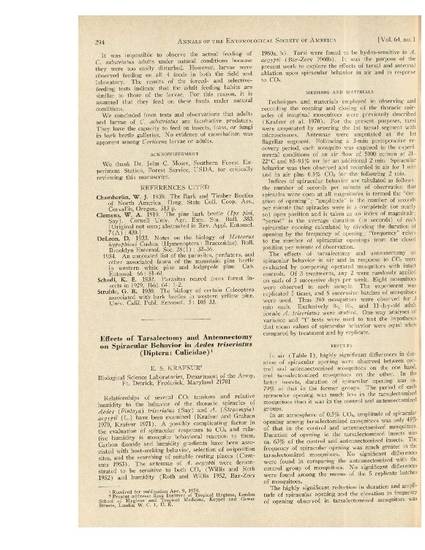
Article
Effects of Tarsalectomy and Antennectomy on Spiracular Behavior in Aedes triseriatus (Diptera: Culicidae)
Annals of the Entomological Society of America
(1971)
Abstract
Relationships of several CO2 tensions and relative humidity to the behavior of the thoracic spiracles ofAedes (Finlaya) triseriatus (Say) and A. {Stegomyia) aegypti (L.) have been examined (Krafsur and Graham 1970, Krafsur 1971). A possibly complicating factor in the evaluation of spiracular responses to CO2 and relative humidity is mosquito behavioral reaction to them. Carbon dioxide and humidity gradients have been associated with host-seeking behavior, selection of oviposition sites, and the searching of suitable resting places (Clements 1963). The antennae of A. aegypti were demonstrated to be sensitive to both CO2 (Willis and Roth 1952) and humidity (Roth and Willis 1952, Bar-Zeev 1960a, b). Tarsi were found to be hydro-sensitive in A. aegypti (Bar-Zeev 1960b). It was the purpose of the present work to explore the effects of tarsal and antennal ablation upon spiracular behavior in air and in response to CO2
Disciplines
Publication Date
January, 1971
DOI
10.1093/aesa/64.1.294
Publisher Statement
Works produced by employees of the U.S. Government as part of their official duties are not copyrighted within the U.S. The content of this document is not copyrighted.
Citation Information
E. S. Krafsur. "Effects of Tarsalectomy and Antennectomy on Spiracular Behavior in Aedes triseriatus (Diptera: Culicidae)" Annals of the Entomological Society of America Vol. 64 Iss. 1 (1971) p. 294 - 296 Available at: http://works.bepress.com/elliot-krafsur/6/
